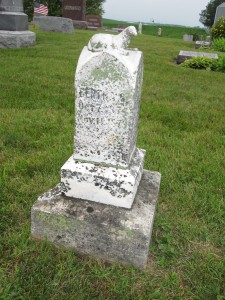In Memory of Cordilia N(illegible)
Consort of John (illegible),
Ship Builder
Who departed this life
September, 21, 1810
in the 63rd year of
her age
(from a tombstone in a cemetery in Alexandria, Virginia)
I have long loved walking through cemeteries. I find them peaceful and strangely life affirming. Why? Most graveyards are quiet oases of stillness and tranquility, green lawns, almost pastures really, with lines of decorative stones and bouquets of flowers dotting the landscape. I especially like older cemeteries with a nice balance of open green space and trees. Life affirming? Absolutely! I like reading the messages on the stones and getting little snapshots of lives lived long ago. Because epitaphs capture what the surviving family believed to be most important about the person who died, the messages can be positive words about a life well-lived.
For sure, the stories some epitaphs tell are sad. The most common is when the deceased’s dates are too close. What a tragedy, the death of a baby or child, hope snuffed out so soon. The sorrow still lingers as I read tombstones of infants or children, but it’s no longer immediate and wrenching, diminished by the years and decades. A recently died close relative’s headstone would obviously be different. Here’s another reason why being surrounded by these signs and words of death can be life affirming: it makes me all the more grateful for my life right now.
I enjoy older cemeteries more than newer ones. Today’s headstones don’t tell you much more than the name and dates of birth and death. Sometimes you get a title or a relationship (Colonel, Father, Wife) and if you’re lucky, you get an adjective (Dearest Mother, Beloved Husband). I wonder if engraving on a stone costs too much these days. I worry we aren’t so good at coming up with words, or maybe we see ourselves as not able to write creatively. That’s too bad. As you might guess, I think just the opposite. I think once a person, almost any person, sets a pen to paper (or chisel to stone) and starts writing, something good and readable and creative will result.
If I were an English teacher, junior high, high school or college, I would assign my students to go to a cemetery and copy a few epitaphs and use one as the basis for a story. The one above, for example, would make for a good tale. Here’s a woman who was born in 1747 in the colonial period. She was married (by “consort” they meant wife) to someone who built ships. The dates show they lived through the American Revolution. Did he build ships for the colonies or for Britain? Were the two close (in the story I would tell about her they probably would be). What was his life like after his wife died, though we don’t know that he had already gone, do we? See what I mean? I think a person could spin quite a yarn with a few details like these as a starting point.
I’m going to be including epitaphs from my collection in this blog over the coming weeks and months. I thought October was an apt month to start. I share them not only because I think they are interesting, but also as another example of how to add words to life, to live literarily. Word collections are easy, inexpensive and fun, something almost anybody could do with a notebook and a pen. Tomorrow I’ll share my favorite epitaph of all, truly fit for a story.

